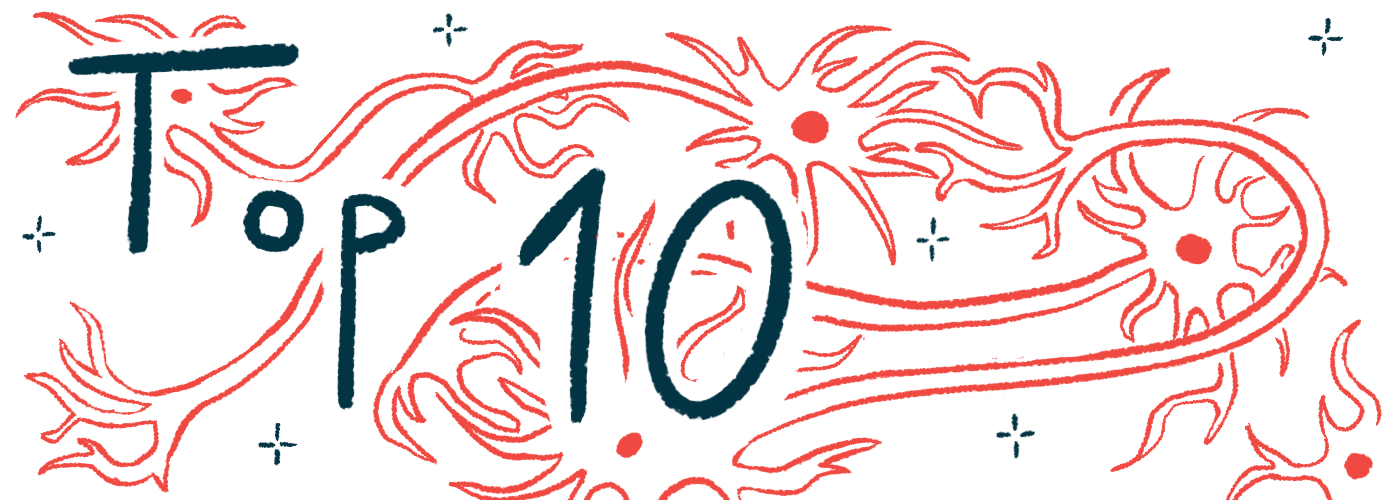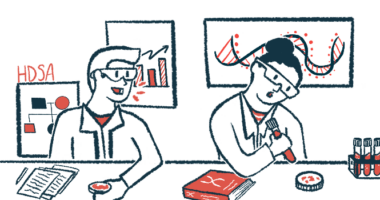Top 10 Huntington’s disease stories of 2023
Trials into a gene therapy, other treatments among widely read coverage

In 2023, Huntington’s Disease News brought you the latest in scientific breakthroughs and treatment developments related to Huntington’s disease.
To recap what interested our readers most this year, here are the top 10 most-read articles, with a brief description of each. We look forward to serving as a continued resource for Huntington’s patients and their caregivers in 2024.
No. 10 – Glial cell transplant shows potential in mouse model
Given that problems in neuron-supporting cells called glia have been increasingly implicated in Huntington’s, scientists explored the therapeutic potential of a transplant in replacing diseased or old glia with new, healthy ones.
The researchers transplanted healthy human glial progenitor, or precursor, cells into the brains of mice engineered so that most of their existing glial precursors were derived from a Huntington’s patient. They found that the transplanted cells grew into healthy glia, replacing the older and diseased ones, suggesting this may be a promising avenue for treating Huntington’s and other diseases characterized by faulty glia.
No. 9 – Early events that lead to toxic huntingtin clumps identified
Researchers discovered why 36 or more repeats of glutamine, a protein building block, in the huntingtin protein are required to cause Huntington’s. These excessive repeats form a long tail, called a polyQ region, that makes the protein prone to forming toxic clumps that harm nerve cells.
The polyQ region of a single huntingtin protein was found to fold in on itself like a zipper, where individual glutamine molecules serve as its teeth. Anything less than 36 repeats, and the region isn’t long enough for the protein to fold in this way, preventing it from forming larger clumps. However, at high huntingtin levels, small clumps started to interfere with each other’s conversion into the growing aggregates. Researchers believe their findings could lead to new therapies to slow disease progression.
No. 8 – Placebo-controlled part of pridopidine Phase 3 trial wraps up
In late March, a last Huntington’s patient enrolled in the international Phase 3 PROOF-HD clinical trial (NCT04556656) of the experimental oral therapy pridopidine completed its final clinic visit, marking the end of the study’s main placebo-controlled part. The therapy, by Prilenia Therapeutics, aims to activate a neuroprotective protein called sigma 1 receptor.
PROOF-HD enrolled 499 people, ages 25 and older, with early-stage Huntington’s and given either oral pridopidine or a placebo twice daily for about 1.5 years. Its main goal was to establish the therapy’s ability to preserve patients’ functional abilities. After completing the placebo-controlled phase, nearly all participants opted to continue or start receiving pridopidine in an ongoing open-label extension phase.
No. 7 – Pridopidine fails to meet Phase 3 trial’s main goal, but may benefit some
About a month after the PROOF-HD trial of pridopidine finished (No. 8 on this list), researchers presented its top-line data at a scientific conference. While the therapy was well tolerated, it failed to meet the main trial goal of slowing patients’ functional decline compared with a placebo, as assessed by the Unified Huntington Disease Rating Scale-Total Functional Capacity scale.
Still, preliminary analyses indicated that pridopidine treatment associated with a trend toward slower disease progression among patients who were not using other Huntington’s therapies, namely antipsychotic medications or chorea treatments.
No. 6 – SAGE-718 earns orphan drug status in EU for Huntington’s
Early in 2023, the European Medicines Agency granted orphan drug designation to SAGE-718, Sage Therapeutics’ investigational oral therapy for Huntington’s. This status intends to help speed the treatment’s clinical development by offering financial incentives and regulatory support. Later in the year, SAGE-718 also was designated an orphan drug in the U.S.
SAGE-718 aims to improve cognitive function by modulating the activity of a brain protein called the N-methyl-D-aspartate receptor that’s involved in learning and memory. Two ongoing Phase 2 trials — DIMENSION (NCT05107128) and SURVEYOR (NCT05358821) — are assessing the treatment’s safety and efficacy against a placebo in Huntington’s patients with cognitive impairments.
No. 5 – ANX005 prevents functional decline in Phase 2a trial
Annexon Biosciences in May shared final data from its Phase 2a ANX005-HD-01 trial (NCT04514367) of ANX005 in 25 people with early Huntington’s or who were at risk for the disease. The therapy was given as regular infusions into the bloodstream for about five months, and patients were followed for the next three months. Results showed that ANX005 stabilized participants’ functional capacity over the study’s nine months, with biomarker analyses suggesting a protective effect against neurodegeneration and neuroinflammation.
The therapy is designed to suppress the C1q protein, whose abnormal accumulation is thought to contribute to chronic neuroinflammation and the loss of nerve cell connections in Huntington’s. Based on the Phase 2a trial’s findings, Annexon noted plans to launch a Phase 2/3 study of ANX005 in people with early-stage Huntington’s.
No. 4 – PTC518 lowers huntingtin levels in PIVOT-HD trial
Interim three-month data from the first 33 Huntington’s patients enrolled in the Phase 2a PIVOT-HD trial (NCT05358717) showed that PTC Therapeutics’ investigational oral therapy PTC518 safely and effectively lowered blood huntingtin levels relative to a placebo.
PTC518 aims to disrupt production of all forms of the huntingtin protein, including the mutant version that clumps and drives neurodegeneration in Huntington’s. PIVOT-HD is evaluating PTC518’s effects over one year on disease biomarkers and MRI readouts against a placebo in up to 252 adults with stage 2 Huntington’s or early stage 3 disease. New enrollment at U.S. sites was paused in 2022; sites elsewhere still may be recruiting.
No. 3 – UniQure plans to advance testing of gene therapy AMT-130
UniQure announced over the summer plans to meet with regulatory agencies early in 2024 to discuss late-stage development of AMT-130, its gene therapy candidate for Huntington’s. Meanwhile, two ongoing Phase 1/2 trials — one in the U.S. (NCT04120493) and one in Europe (NCT05243017) — are evaluating the safety and early efficacy of a low and high dose of AMT-130. Trial updates are forthcoming.
Delivered via direct infusion into the brain, AMT-130 aims to stop production of the mutant huntingtin protein. Early data from the ongoing, five-year U.S. study indicated that either dose of the gene therapy safely preserved treated patients’ clinical and motor function for up to two years relative to Huntington’s natural course.
No. 2 – Phase 1/2a trial of VO659 for Huntington’s, related diseases launches
A first patient was dosed in the first trial of Vico Therapeutics’ experimental VO659 therapy in people with Huntington’s and certain other neurological conditions. The treatment is designed to prevent the production of proteins with harmful polyQ regions, by targeting the intermediate molecule derived from DNA that serves as template for the production of mutant proteins like toxic huntingtin.
The Phase 1/2a trial (NCT05822908) aims to enroll up to 65 adults with Huntington’s or certain forms of spinocerebellar ataxia, a condition also characterized by polyQ proteins. All participants will receive multiple doses of the therapy via injection into the spinal canal (intrathecal injection), with the main goal of evaluating safety and tolerability. The study is set to conclude in 2025.
No. 1 – Tominersen clinical trial focusing to early-stage Huntington’s
The most widely read story of 2023 concerned the launch of a Phase 2 trial of tominersen, Roche’s therapeutic candidate, in people with early Huntington’s symptoms and those in prodromal disease stages, prior to symptom onset. Called GENERATION HD2 (NCT05686551), the international and placebo-controlled study is enrolling an estimated 300 participants, ages 25 to 50.
Tominersen, given via intrathecal injections, works to reduce levels of all forms of the huntingtin protein as a way of slowing disease progression. While data from the previous Phase 3 GENERATION HD1 trial (NCT03761849) found no benefit with tominersen relative to a placebo in adults with manifest disease, younger patients with less severe disease and those on less frequent dosing showed positive trends. GENERATION HD2 participants will receive a less frequent dosing regimen of tominersen or a placebo, and will be assessed for safety and changes in mutant huntingtin and functional capacity.
At Huntington’s Disease News, we hope these stories and the rest of our 2023 coverage helped to better inform and improve the lives of you, our readers in the Huntington’s community.
We wish you all a very happy new year!






